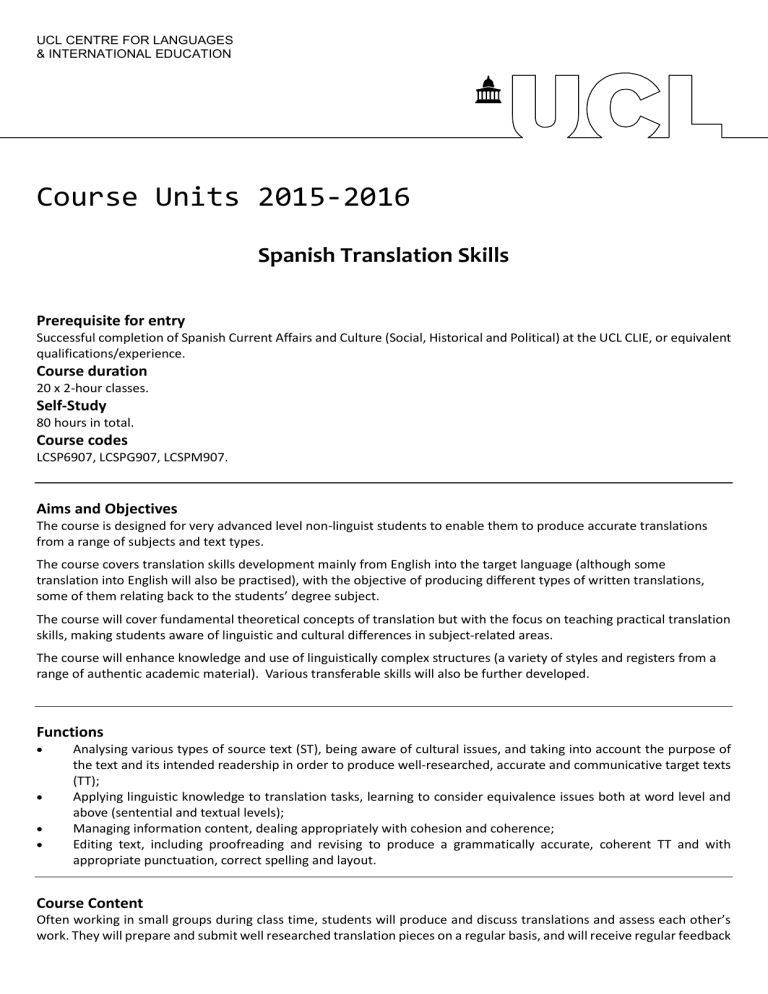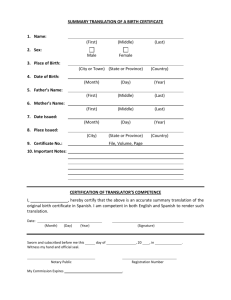Course Units 2015-2016 Spanish Translation Skills Prerequisite for entry

UCL CENTRE FOR LANGUAGES
& INTERNATIONAL EDUCATION
Course Units 2015-2016
Spanish Translation Skills
Prerequisite for entry
Successful completion of Spanish Current Affairs and Culture (Social, Historical and Political) at the UCL CLIE, or equivalent qualifications/experience.
Course duration
20 x 2-hour classes.
Self-Study
80 hours in total.
Course codes
LCSP6907, LCSPG907, LCSPM907.
Aims and Objectives
The course is designed for very advanced level non-linguist students to enable them to produce accurate translations from a range of subjects and text types.
The course covers translation skills development mainly from English into the target language (although some translation into English will also be practised), with the objective of producing different types of written translations, some of them relating back to the students’ degree subject.
The course will cover fundamental theoretical concepts of translation but with the focus on teaching practical translation skills, making students aware of linguistic and cultural differences in subject-related areas.
The course will enhance knowledge and use of linguistically complex structures (a variety of styles and registers from a range of authentic academic material). Various transferable skills will also be further developed.
Functions
Analysing various types of source text (ST), being aware of cultural issues, and taking into account the purpose of
the text and its intended readership in order to produce well-researched, accurate and communicative target texts
(TT);
Applying linguistic knowledge to translation tasks, learning to consider equivalence issues both at word level and above (sentential and textual levels);
Managing information content, dealing appropriately with cohesion and coherence;
Editing text, including proofreading and revising to produce a grammatically accurate, coherent TT and with appropriate punctuation, correct spelling and layout.
Course Content
Often working in small groups during class time, students will produce and discuss translations and assess each other’s work. They will prepare and submit well researched translation pieces on a regular basis, and will receive regular feedback
on their work. Texts will be chosen from a range of topics and domains, and taking into account the students’ areas of studies. These may include:
Science and technology;
International relations and global issues;
Business, trade and economics;
Social sciences;
Law;
Art and literature.
Skills
Reading
Reading for gist, scanning for specific information in source texts;
In-depth analysis of topics in relevant publications;
Developing research skills for translation;
Comparing information content in source and target texts;
Revising and proofreading.
Writing
Producing communicative translations from English into Spanish and Spanish into English;
Editing texts, writing summaries in the target language;
Adapting text according to specific readership;
Writing glosses, translator’s notes, annotations and short text analyses using appropriate language and using key theoretical concepts.
Speaking
Explaining own translation strategy and choices, using some of the fundamental translation theory concepts appropriately.
Linguistic Structures
Discourse Strategies
Analysing/comparing texts from various sources (different text types, styles and registers);
Adapting translation strategy according to text features and the purpose of ST and TT;
Working within the constraints of multimodal discourse, e.g. film subtitling.
Main Aspects of These Strategies
Structuring (logical structures);
Linking devices (lexical and grammatical cohesion);
Textual and Pragmatic equivalence, awareness of registers and styles;
Use of appropriate collocations;
Appreciation of embedded meaning in discourse;
Acquisition of terminology relevant to specific domains and to student’s area of studies.
Learning Resources
There is no textbook for this course, although extracts from the following texts may, at times be given to read:
In Other Words: a Course book on Translation M. BAKER 1992 (Routledge)
Thinking Spanish Translation: a Course in Translation Method: Spanish into English 2 nd Edition, Louise Haywood,
Michael Thompson, Sándor Hervey, Published March 31st 2009 (Routledge)
Regular access to large bilingual and monolingual dictionaries is essential for this course.
Materials for the course will be drawn from authentic written material from various sources, to be provided by the tutor.
In addition there is a wide range of language-learning materials






